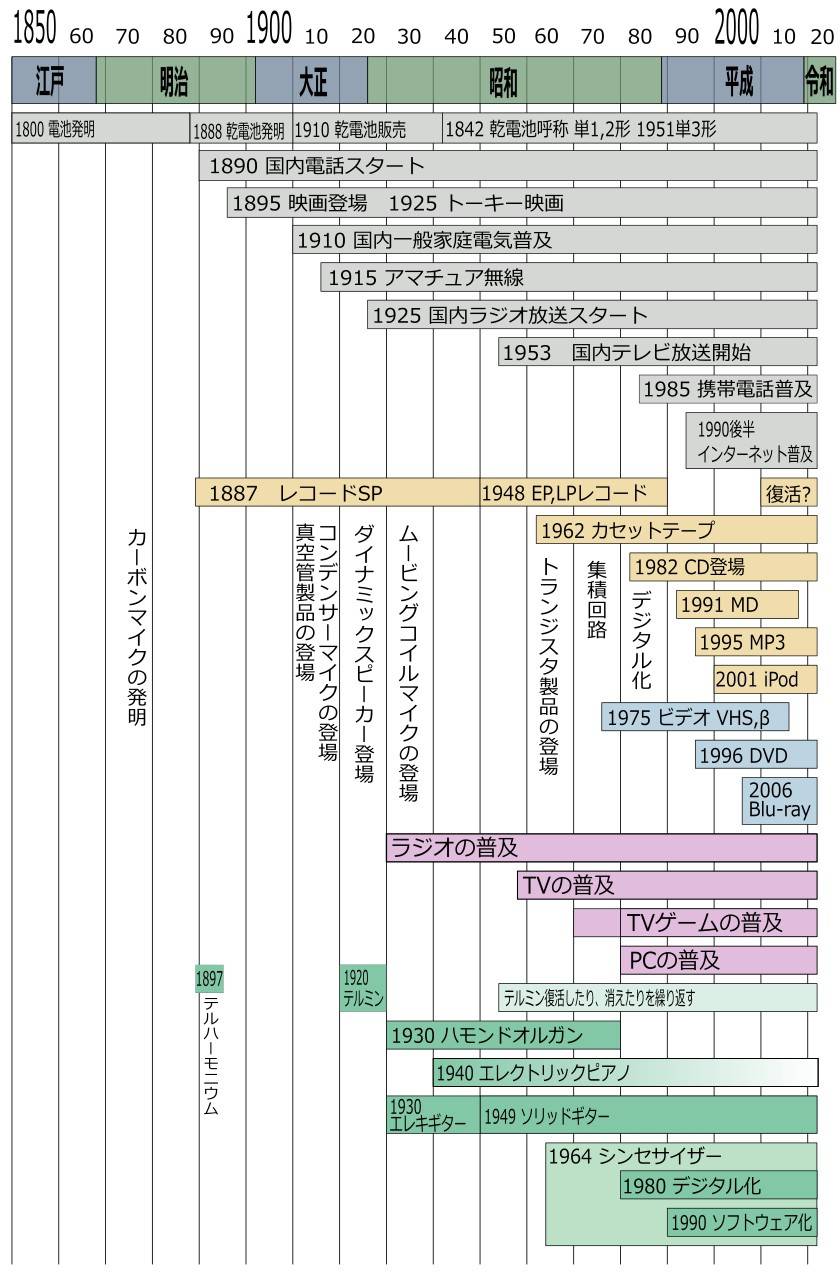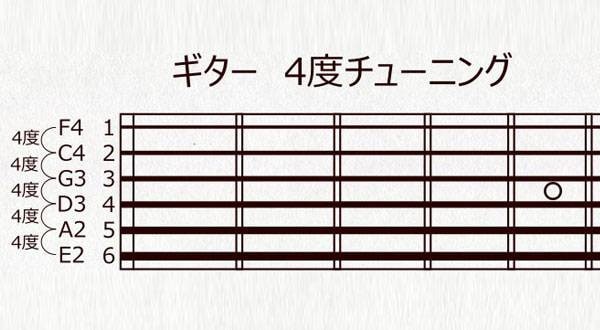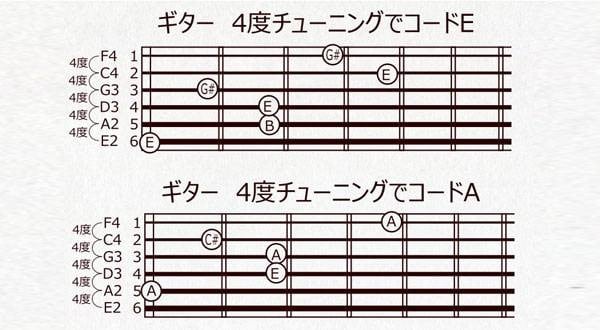In these modern times, music and electricity have become inseparable. I have roughly outlined the relationship between electricity and music from the Meiji era to the present in a table.

■ Infrastructure Related to Sound
Infrastructure is important when it comes to utilizing electricity. I’ve listed various items related to sound, such as batteries, electricity, and communication.
The history of batteries is long and most early electrical machines were powered by batteries. The current form of batteries was inherited from the Taisho era. After the war, small batteries began to be produced as well.
Household electricity gradually spread from the Taisho era. In the early stages, it was mainly used for lighting and heating equipment, but after the war, it began to be used for many other purposes.
Communication started with the telephone, followed by wireless, radio, television, mobile phones, and the internet. It is the foundation of information, and the music industry has been greatly influenced by it.
Cinema started in the late Meiji period and it developed significantly as a popular form of entertainment. Initially, films were silent, and live narrators or musicians were responsible for the sound. This continued for about 30 years. The era of silent films lasted for a long time because there weren’t sufficient playback devices with adequate volume. With the advent of the Showa era, playback devices became practical, and films with sound, called "talkies" replaced the silent films.
■ Elements of Technology and Media
Music was originally performed live. From the Meiji period onwards, it changed with various technological innovations, growing into a major industry.
The first practical sound devices were phonographs and telephones. Telephones used batteries, while phonographs were entirely mechanical and did not use electricity. As a result, the volume wasn’t very loud. Later, records were standardized, and improvements in both volume and sound quality were remarkable, leading to widespread adoption in households. The mass production of records completely changed the landscape of the music industry. Additionally, with the collaboration between radio and television, the music industry expanded even further. As records were replaced by CDs, the same business model continued. However, after 2000, with the widespread use of the internet and the digitization of music, the traditional mass-market model began to collapse. It’s clear that industries are built on technological innovation and infrastructure, and new methods always need to adapt to the times.
Looking at the technological elements, development has followed the sequence of the aforementioned recording devices, microphones as the sound input device, amplifiers using vacuum tubes and transistors, and finally, speakers as the sound output device. The carbon microphone, which was invented in the Meiji period, was excellent in that it didn't require an amplification device, and was used until the 1980s. The development of electric amplification devices was not possible until vacuum tube technology stabilized, and until then, speakers like the ones we have today did not exist. Similarly, current microphones also require amplifiers, meaning that we are in a similar situation. Without amplification devices, the development of electric sound equipment would have been difficult. When vacuum tubes became practical and products started to be made in the 1910s, microphones, speakers, and electric instruments developed rapidly. By the 1960s, vacuum tubes were replaced by transistors, enabling smaller and more affordable devices to be produced. This also made computers more practical, leading to a dramatic leap forward in development. In the 1980s, the digital era began in earnest, and many audio devices became digital. As PCs became more powerful, software took over, and physical devices were emulated.
■ Instruments and Electricity
Instruments that developed after the introduction of vacuum tube amplifiers and dynamic speakers became capable of producing sufficient volume. The theremin, a famous electronic instrument, was invented in 1920 but failed to gain success and was largely forgotten for a long time. However, it made a comeback when synthesizer pioneer Moog began manufacturing and selling theremins. Since then, the theremin has intermittently gained attention due to its novelty.
From the 1930s onwards, practical playback devices began to be produced, and alongside them, instruments like the Hammond organ became widespread. As electronic technology advanced and it became cheaper to produce electronic instruments, devices like the Hammond organ, which were considered electromechanical, declined due to their high price and lack of convenience. Similarly, electric pianos, which physically produce sound and are electrically amplified, also faded as electronic technology improved and were replaced by electronic instruments or synthesizers. The progression from analog circuits using transistors to digitalization with ICs, and then to software-based systems, followed the same path as other electronic devices.
Guitars, which previously had low volume, were able to achieve louder volumes through the use of electricity, and this opened up new possibilities for electric guitars. However, the basic principles of electric guitars have not changed much since their inception in the 1930s, and compared to other fields, they have remained relatively primitive. This suggests that unless there is a specific demand, further development is unlikely. This could be seen as a state of "Galapagosization", where the technology evolves in isolation without broader influences.
■ The Flow of the Last 100 Years
When looking at the larger trends over the past century, there are always key technological elements that stand out. These elements, along with surrounding technologies, have developed together, giving rise to industries that either flourished or faded. It’s clear that many fields have combined and influenced each other, and over periods of 10 or 20 years, we can see significant shifts in the overall direction. The process seems reminiscent of biological evolution. While some species experience rapid evolution, others are weeded out. There are even species that continue to exist in much the same form as they always have.
Since the 2000s, the internet has undoubtedly become the central driving force of the era. Not only have physical products been converted into software, but existing services and media have also been absorbed into the digital realm. This momentum is expected to continue for some time.
The “sound & person” column is made up of contributions from you.
For details about contributing, click here.













![Enchanting Instruments 22 - Voice 5 [Resonance]](/contents/uploads/thumbs/5/2021/11/20211124_5_15249_1.jpg)
![Enchanting Instruments 21 - Voice 4 [Vocal Cords]](/contents/uploads/thumbs/5/2021/11/20211116_5_15166_1.jpg)
![Enchanting Instruments 20 - Voice 3 [The Breath Part 2]](/contents/uploads/thumbs/5/2021/11/20211116_5_15167_1.jpg)

 ライブ配信に必要な機材を徹底解説 オンラインライブの創り方
ライブ配信に必要な機材を徹底解説 オンラインライブの創り方
 JBL スピーカー特集
JBL スピーカー特集
 QSC パワードスピーカー CPシリーズ
QSC パワードスピーカー CPシリーズ
 DTMセール情報まとめ
DTMセール情報まとめ
 サブウーファーとは
サブウーファーとは
 スタジオモニタースピーカーを選ぶ
スタジオモニタースピーカーを選ぶ















